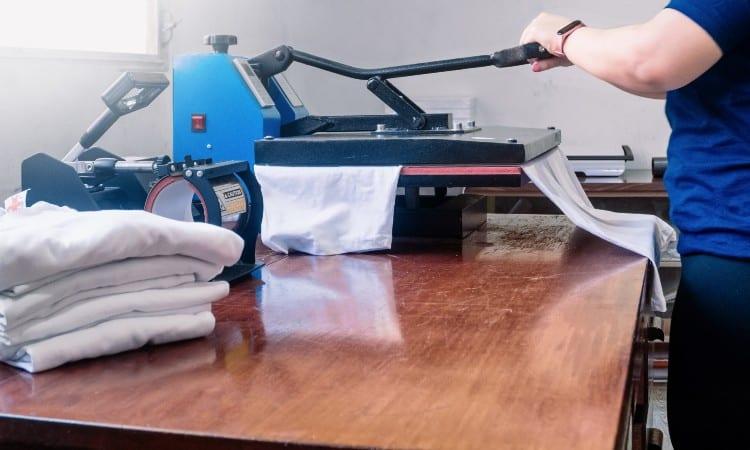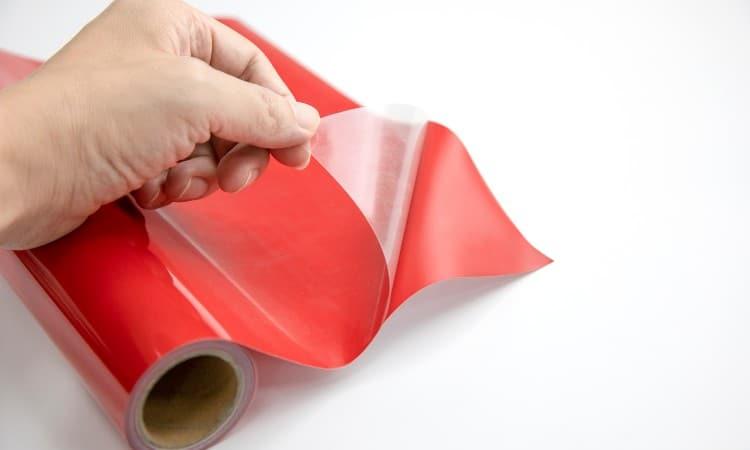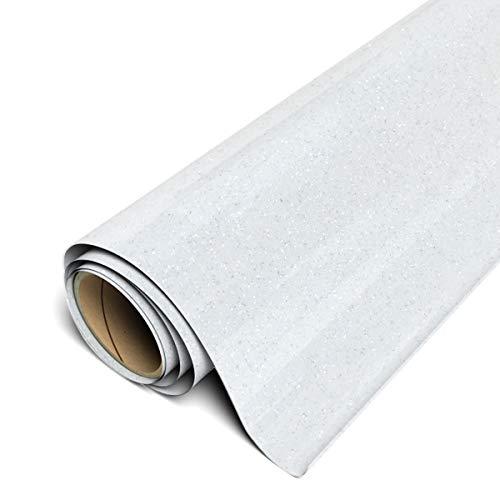One of the big issues with many t-shirt printing methods is that they do not show up well on dark-colored fabrics. Sublimation printing is no exception unless you sublimate onto the medium of vinyl. If you want to learn how to make prints on dark t-shirts pop, check out this complete guide to sublimation on vinyl!
Sublimation printing on vinyl begins with selecting a type of heat transfer or adhesive vinyl with a polyester coating. The printer can either print an image onto the vinyl or use a transfer sheet to place a design on the vinyl. A heat press with precise temperature and timing will activate the sublimation process.
You are viewing: What Vinyl Can You Sublimate On
In this article, you will learn how sublimation printing works on vinyl surfaces. You will learn how to sublimate on popular types of vinyl such as HTV and clear vinyl. Finally, you will discover what temperature and timing to use with a heat press on vinyl.
What is Sublimation Printing?

Sublimation printing uses heat to transfer ink onto a blank like a t-shirt. This printing method creates stunningly vivid full-color designs that don’t fade, crack, or peel like other printing techniques. This process uses special synthetic dyes and sublimation transfer paper.
The term “sublimation” means a physics process in which a solid turns into a gas without becoming a liquid in between. When you expose dried sublimation dyes to the high heat of a heat press, the ink enters a gaseous state that allows it to bond with polyester fibers. Then it cools down into a solid state again and remains deeply embedded in the polyester.
One big reason this newer printing method has taken off so fast in the t-shirt industry is that sublimation prints hold up over time better than other printing methods like DTG. This is because of the way the gaseous ink sinks inside the polyester fibers and fuses into the fabric instead of resting on top of the cloth like other types of ink.
The basic steps of sublimation printing look like this:
- First, you have to create a digital image on your computer. You can use full-color photos or simple lettering. The sublimation design will create a rich, crisp image either way!
- Next, you mirror or flip the digital image so that it will print out backward.
- You use a sublimation printer loaded with special disperse dyes to print the image onto a transfer paper. The special physics process of sublimation only works when you use the appropriate kind of ink.
- Then arrange the transfer sheet on top of the t-shirt or other blank. You can sublimate designs onto many surfaces, like ceramics, banners, and t-shirts. The only catch is that the blank has to have a polyester coating or contain a high percentage of polyester.
- Finally, you use a heat press to transfer the design on the paper to the t-shirt and then peel away the paper.
Can You Sublimate on Vinyl?

You can sublimate on many kinds of vinyl using several different methods like printing directly onto vinyl, sublimating the design onto vinyl before pressing, or sublimating the design onto vinyl after heat pressing the vinyl onto the blank. You can also sublimate onto many different types of vinyl, including white or glitter HTV and some forms of adhesive vinyl.
The advantage of sublimating onto vinyl instead of directly onto your blank (such as your t-shirt or hoodie) is that the vinyl provides a great backdrop for colorful designs. If you print a photo onto a black t-shirt, the colors will appear muted and will not stand out from the dark fabric. Plus, you can’t create white ink, so any white or light areas of the design will appear black instead.
To solve this problem, some printers apply a thin layer of white ink as a base coat before printing. But this often cracks and peels over time. Vinyl, in contrast, will form a soft raised surface on the fabric that will last through many washes without any damage. And the sublimation design printed onto the vinyl will last forever!
The other major reason to sublimate onto vinyl instead of directly onto a t-shirt is that this method allows you to put sublimation prints on cotton shirts. Normally, you can only sublimate onto polyester tees. But if you have the medium of the vinyl in between the ink and the fabric, you can put your sublimation print on soft, comfy cotton instead!
Depending on the kind of vinyl you use, you will want to use slightly different printing methods.
Sublimation on Vinyl: Complete Guide

You can sublimate on several kinds of vinyl, like HTV, glitter vinyl, and some adhesive vinyl. This guide will show you step-by-step how to sublimate vinyl for a t-shirt or a permanent sticker to place on an item like a laptop or water bottle.
Permanent Vinyl
The best way to sublimate on permanent vinyl is to use transfer paper cut in the same shape as the vinyl.
Read more : What Is Kenya Known Famous For
Permanent vinyl contains a super strong adhesive backing that makes it impossible to remove from most surfaces after application. This differs from some peel-and-stick removable vinyl, which use weak adhesives. When you say permanent vinyl, you typically mean adhesive vinyl rather than a heat-transfer variety.
You can successfully sublimate onto many types of permanent vinyl, including white or clear vinyl and even heavy-duty outdoor types like Oracle 651.
- Create your digital design and mirror the image before printing it onto sublimation transfer paper.
- Next, send your permanent vinyl through your electronic cutting machine to cut out the outline of the shape you used for the print design. Make sure you do not mirror the cut image, though.
- Use heat-safe tape like ThermoTape to attach the transfer paper face-down on top of the vinyl. Place a sheet of parchment paper on top and bottom of the vinyl and transfer paper.
- Set your heat press to 350℉. You will use a pressing time of just 25 seconds for this kind of vinyl.
- This should create a beautiful sublimation print on the vinyl, which you can peel up to use as a sticker later on!
HTV Vinyl

Sublimating onto HTV, or heat-transfer vinyl gives you the perfect way to add graphics to t-shirts and many other items. This is the most popular method to use by far, but you can only sublimate onto certain types of HTV. The surface of the HTV has to contain a good amount of polyester for this process to work. Some types of HTV even have special polyester coatings on top of the vinyl to make this easier!
The easiest way to find HTV for sublimation is to buy products that specifically say “vinyl for sublimation” in the product description.
HTV stands for heat-transfer vinyl, which consists of a thin top layer and a heat-activated adhesive on the back. HTV can come in many different finishes and every color imaginable. The basic type has a matte finish, but you can find everything from glitter and camo HTV to neon or glow-in-the-dark HTV!
The easiest way to sublimate onto HTV is to use the heat press for sublimation with the vinyl attached to the shirt or blank.
- As always, you start at the computer with a digital image. Print this out onto sublimation transfer paper using a sublimation printer. Make sure you reverse or mirror the image, as you apply the print face-down onto the HTV.
- Next, open up the program you use to run your electronic cutting machine for vinyl. Use the trace function to cut out a shape from the HTV just ⅛” of an inch smaller than the sublimation print.
- Send the cut file to the cutting machine.
- Apply the HTV shape to the shirt and use your heat press to seal the HTV to the shirt according to the temperature on the vinyl packaging. This will vary based on the kind of HTV you use, but many types require a temperature of around 320℉ to 350℉.
- The package should also recommend a pressing time. You want to use only about half that time for the first press because you will need to use the heat press again in a minute for the sublimation process.
- If the HTV recommends a warm peel, remove the plastic carrier film right away at this point. If it needs a cool peel, let the shirt cool down before you touch it.
- Now go back to the sublimation transfer paper. For a simple shape like a circle, you can cut out around the outline of the design by hand. For a complicated shape, use your Circut or electronic cutting machine again to cut it out.
- Align the transfer print side down on top of the HTV. The transfer should just overlap the edges of the HTV. You may want to use heat-resistant tape to secure it in place.
- Carefully smooth a protective Teflon sheet over the whole thing.
- To cause sublimation, you need to set the heat on your press to at least 375℉. Once this heats up, press the transfer and vinyl together on the shirt for 30 seconds.
- Finally, remove the transfer paper and admire your bright design!
Glitter Vinyl
One of the most popular types of HTV to use for sublimation is glitter vinyl because the tiny flecks of plastic that form the glitter often contain 100% polyester. Since you have to sublimate onto a polyester surface, this makes sense! The glitter also provides a fun, sparkly background for vibrant prints.
In most cases, you will want to try this method with white glitter HTV unless you want a light green or pink as the background for stylistic reasons.
To sublimate onto glitter HTV, you follow almost all the above steps for sublimating on regular HTV. The only variation is in timing and temperature.
- Follow the directions on the glitter HTV package to pick the right temperature to pre-press the glitter HTV shape onto the shirt, but make sure you use only half the recommended pressing time at this stage.
- To sublimate onto glitter HTV, place the transfer sheet print face-down on the glitter and use a temperature of 390℉ to 400℉.
- You normally need to press for a full minute to complete the sublimation. You may want to do a sample run and try just 30 seconds first to see if that produces vivid results, though, as the precise timing can vary depending on the brand of glitter HTV you select.
White Vinyl
The best way to use sublimation vinyl for dark shirts is to choose a type of white vinyl with either a polyester coating or a high polyester content. This will make your design pop and look bright against the dark fabric of the shirt.
You can follow the steps described in the “how to sublimate on HTV” section above, but you can also choose to sublimate onto white HTV before applying the vinyl to your blank. This allows you to save the shape for later use.
- Prep your image and print it out onto sublimation paper.
- Use the trace function to cut out a white HTV shape, just a hair smaller than the outline of the print.
- Cut out the vinyl and peel it off the plastic carrier sheet.
- Carefully place the white HTV face down (with the adhesive side facing up) on top of the print.
- Smooth a sheet of transfer tissue over the adhesive backing of the HTV.
- Set the press to 375℉.
- Close the heat press for thirty seconds to one minute, depending on the kind of vinyl and the size of the design.
Cricut Vinyl
You can effectively sublimate on certain types of Circut-brand vinyl, so long as it has a polyester coating. Circut’s white glitter HTV works especially well for this purpose.
As one of the most popular electronic cutting machine brands, Cricut made a huge name for itself in the world of vinyl. You can use Circut vinyl to decorate t-shirts, mugs, or baseball caps. You can also use different types of Cricut vinyl to make stickers or clear decals.
The other great thing about working with a Cricut is that you can use the free online Design Space to create your digital image and easily translate that into a cut file.
- As with any vinyl for sublimation, you need to check whether or not a certain type of Cricut vinyl contains polyester before trying to sublimate onto it.
- You cannot sublimate onto printable Cricut vinyl. The papery surface on this type works with inkjet printers, not with special sublimation dyes.
- Cricut’s line of infusible ink products does not work with sublimation, as they use a slightly different chemical process.
Clear Vinyl
You can sublimate onto clear permanent vinyl quite easily. This is a popular way to create designs to place on mugs, tumblers, computers, and phone cases, among other items. Unlike HTV, you will not use heat to attach the vinyl to the blank with this technique-it will simply adhere like a super strong sticker.
- Create and print the digital image onto sublimation transfer paper. As usual, make sure you mirror the image.
- Use an electronic cutting machine to cut out clear vinyl in the shape you want. You may want to use the trace function to make this shape larger than your printed design. But in many cases, you want a more generic shape, like an oval or a square, to form the sticker’s outline.
- Next, cut two pieces of parchment paper larger than the clear vinyl shape.
- In your heat press, layer one sheet of parchment paper, then the clear vinyl, then the transfer paper (face down on the vinyl), and then another piece of parchment paper.
- Press for 25 to 30 seconds using a temperature of 350℉.
- Open the heat press and gently peel away the transfer paper, leaving the design fused to the clear sticker!
Oracle 651
You can sublimate onto outdoor adhesive vinyl like Oracle 651 in the same way you would on any clear vinyl. This is a heavy-duty sign vinyl, perfect for making banners. You can also print directly onto this vinyl by adding multiple coats of a polyester spray like Krylon ColorMaster Clear.
Read more : What Is Google Llc Background On Mac
Generally speaking, using a sublimation printer to apply the ink directly to vinyl does not work well because the ink will smear or form tiny droplets on the plasticky surface. This is why you print your design onto a transfer sheet and then use heat and the sublimation process to fuse the ink with your blank.
However, you can create a better surface for the ink by using some types of sprays.
- Apply two or three coats of a clear spray paint coat like Krylon’s clear color master brand.
- Use a heat gun (or a hair dryer on low) to dry the vinyl between each coat of spray.
- Print your design onto the sheet of coated vinyl.
- Use the heat gun again to dry the ink.
- Then apply one more layer of coating spray.
- Sandwich your printed vinyl between two sheets of parchment paper and heat press it for 20 seconds at a temperature of 350℉.
Press Time and Temperature to Sublimate on Vinyl
The press time and temperature to sublimate on vinyl can vary depending on the type of vinyl you use. To initiate the sublimation process, your heat press needs to reach a temperature of at least 350℉, and you can sometimes use a temperature as high as 400℉ if the kind of vinyl allows it.
Any kind of heat press will work for this process. You can use a small hand-held type like the Cricut EasyPress, or a large clamshell-style press.
Type of Vinyl Temperature Press Time Permanent 350℉ 30 seconds Clear Permanent 350℉ 25 seconds HTV 375℉ 30 seconds Glitter HTV 390℉ 30 seconds Oracle 651/Heavy Duty Permanent 350℉ 30 seconds
Best Vinyl for Sublimation
 The best vinyl for sublimation is white glitter HTV because most types of glitter HTV use polyester flakes for the glitter particles. This makes sublimating onto the surface super easy! The glitter also creates an interesting slightly raised texture in the design, which can look nice on a t-shirt or fabric bag.
The best vinyl for sublimation is white glitter HTV because most types of glitter HTV use polyester flakes for the glitter particles. This makes sublimating onto the surface super easy! The glitter also creates an interesting slightly raised texture in the design, which can look nice on a t-shirt or fabric bag.
Popular brands of white glitter HTV for sublimation include:
- Siser makes many types of vinyl, which you can buy in single paper-sized sheets or large rolls. Many DIY home printers prefer Siser for sublimation.
- Cricut iron-on glitter is also a popular type of white glitter HTV for sublimation. Again, you can buy it in sheets or larger rolls.
- Firefly Craft also offers another option for white glitter, perfect for sublimation.
Of course, as you know earlier in this article, you can also sublimate onto some types of clear permanent vinyl! Brands like Amazon’s HTVRONT work well for this.
Some brands of matte or glossy white vinyl will also work for sublimation. In fact, after white glitter HTV, white HTV is the most popular choice of vinyl for sublimation on t-shirts or fabric items.
Can a Sublimation Printer Print on Vinyl?
A sublimation printer cannot easily print directly onto vinyl. In most cases, your design will come out with perfect lines and vivid colors when you print it onto a sublimation transfer sheet first and then use heat to transfer the ink to the vinyl.
You can work around this by using special sprays or coatings on the vinyl before printing if you want to print on vinyl with a sublimation printer. But it is much easier to just use transfer paper!
What Materials Can You Not Sublimate On?
You can not sublimate on any material that does not have a polyester coating. This is kind of a trick question because you can order blanks made out of pretty much anything so long as they have a sublimation coating. For example, printing companies often sublimate onto banners, tiles, mugs, glass doors, and more!
But you cannot sublimate onto plain glass, ceramic, or cotton. Sublimation only works well on polyester or a polyester coating applied to another material.
This is because the heat used to turn sublimation dyes into gas will open up the fibers inside the polyester. The gaseous ink then flows inside those fibers. When everything cools, the polyester fibers will close back up, trapping the dye particles permanently. If you try to sublimate on 1005 cotton, most synthetic dyes will simply wash away the first time you rinse the cotton.
One of the main reasons to sublimate onto vinyl is because it serves as a medium between your design and a surface that you can’t directly sublimate on. For example, if you want a sublimation print on a cotton shirt, you can put HTV between the print and the cotton to make the process work, even though you can directly place your sublimation paper onto the cotton.
Conclusion
Sublimation printing uses heat to turn synthetic dyes into a gas that can permanently fuse with a surface like some types of vinyl. The basic process of sublimating onto vinyl involves printing a design onto transfer paper using synthetic dyes and a sublimation printer. Sometimes, you need to use an electronic cutting machine to cut out the shape of the print and the vinyl before using a heat press to transfer the color onto the vinyl.
The most popular type of vinyl to sublimate on is white glitter HTV. Other popular choices include clear permanent adhesive vinyl for stickers and white matte HTV for designs on t-shirts. The temperature and timing you use with the heat press will vary based on the type of vinyl you choose.
Source: https://t-tees.com
Category: WHAT
